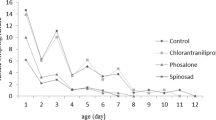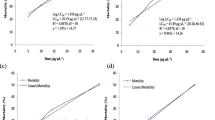Abstract
The toxicity of spinosad was evaluated using the RaPID Assay® Spinosad immunosorbent assay in different developmental stages of the parasitoid, Hyposoter didymator, and in its host, fourth-instar larvae of the cotton leafworm Spodoptera littoralis. Spinosad was applied directly to pupae and adults of H. didymator (ingestion or topical application) or to the immature stages of the parasitoid via the host larvae. Low amounts of spinosad were recovered from S. littoralis host larvae after topical treatment, and the compound was mainly retained in the hemolymph. Amounts of spinosad detected in third-instar larvae of H. didymator, pulled out from the hemolymph of parasitized S. littoralis larvae, were 85 pg (3.57 ng a.i./g body weight) in dead larvae, and 82 pg (3.42 ng a.i./g body weight) in alive individuals. After topical treatment of H. didymator cocoons, most of the compound was retained in the silken cocoon, preventing contamination of the pupa. Also in the parasitoid adults, relatively low amounts of spinosad were accumulated in the body overall, but half of all the insecticide recovered was found in the ovaries. The kinetic results obtained help to better understand the toxicity of spinosad in the complex S. littoralis–H. didymator, and to ascertain the compatibility between spinosad and the parasitoid for optimizing the control of lepidopteran pests.

Similar content being viewed by others
References
Alford DV (2000) Pest and disease management handbook. British Crop Protection Council, Blackwell Science, Oxford, 615 pp
Bahena F, Budia F, Adán A, Del Estal P, Viñuela E (1999) Scanning electron microscopy of Hyposoter didymator in host Mytimna umbrigera larvae. Ann Entomol Soc Am 92:144–152
Bailey J, Scott-Dupree C, Harris R, Tolman J, Harris B (2005) Contact and oral toxicity to honey bees (Apis mellifera) of agents registered for use for sweet corn insect control in Ontario, Canada. Apidologie 36:623–633
Bellows TS, Fisher TW (eds) (1999) Handbook of biological control. Academic Press, San Diego, 1046 pp
Caballero P, Vargas-Osuna E, Adebis H, Santiago-Alvarez C (1990) Parasitoides asociados a poblaciones naturales de Spodoptera littoralis Boisduval y S. exigua Hb. (Lepidoptera: Noctuidae). Bol San Veg Plagas 16:91–96 (in Spanish with English abstract)
Figueiredo E, Mexía A (2000) Parasitoid complex associated with Lepidoptera on horticultural protected crops in the west region of Portugal. IOBC/wprs Bull 23:205–208
Guimaraes FR, Vargas-Osuna E, Maracajá PB, Santiago-Alvarez C (1995) Presencia de Spodoptera exigua Hb. (Lep: Noctuidae) y sus agentes bióticos asociados en la provincia de Córdoba. Bol San Veg Plagas 21:641–646 (in Spanish with English abstract)
Hassan SA (1994) Activities of the IOBC working group pesticides and beneficials. IOBC Bull 17:1–5
Ingram WR (1981) The parasitoids of Spodoptera littoralis (Lep: Noctuidae) and their role in population control in Cyprus. Entomophaga 26:23–37
Izquierdo JI, Solans P, Vitalle J (1994) Parasitoids and predators of Helicoverpa armigera (Hb) in tomato crops. Bol San Veg Plagas 20:521–530
Kumar P, Ballal CR (1992) The effect of parasitism by Hyposoter didymator (Hym: Ichneumonidae) on food consumption and utilization by Spodoptera litura (Lep: Noctuidae). Entomophaga 37:197–203
Kim D-S, Brooks DJ, Riedl H (2006) Lethal and sublethal effects of abamectin, spinosad, methoxyfenozide and acetamiprid on the predaceous plant bug, Deraeocoris brevis in the laboratory. BioControl 51:465–484
Medina MP, Budia F, Tirry L, Smagghe G, Viñuela E (2001) Compatibility of spinosad, tebufenozide and azadirachtin with eggs and pupae of the predator Chrysoperla carnea (Stephens) under laboratory conditions. Biocontrol Sci Technol 11:597–610
Pineda S, Smagghe G, Schneider MI, Del Estal P, Viñuela E, Martinez AM, Budia F (2006) Toxicity and pharmacokinetics of spinosad and methoxyfenozide to Spodoptera littoralis (Lepidoptera : Noctuidae). Environ Entomol 35:856–864
Quicke DLJ (1997) Parasitic wasps. Chapman & Hall, London, 470 pp
Salgado VL (1998) Studies on the mode of action of spinosad: insect symptoms and physiology correlates. Pestic Biochem Physiol 60:91–102
Schneider MI, Smagghe G, Gobbi A, Viñuela E (2003a) Toxicity and pharmacokinetics of insect growth regulators and other novel insecticides on pupae of Hyposoter didymator (Thunberg 1822) (Hym., Ichneumonidae), a parasitoid of early larval instars of Noctuid pests. J Econ Entomol 96:1054–1065
Schneider MI, Smagghe G, Viñuela E (2003b) Susceptibility of Hyposoter didymator (Hymenoptera: Ichneumonidae) adults to several insect growth regulators and spinosad by different exposure methods. IOBC/wprs Bull 26:111–122
Schneider M, Smagghe G, Viñuela E (2004a) Comparative effects of several insect growth regulators and spinosad on the different developmental stages of the endoparasitoid Hyposoter didymator (Thunberg). IOBC/wprs Bull 27:13–19
Schneider MI, Smagghe G, Pineda S, Viñuela E (2004b) Action of insect growth regulator insecticides and spinosad on life history parameters and absorption in third-instar larvae of the endoparasitoid Hyposoter didymator. Biol Control 31:189–198
Semiz G, Cetin H, Isik K, Yanikoglu A (2006) Effectiveness of a naturally derived insecticide, spinosad, against the pine processionary moth Thaumetopoea wilkinsoni Tams (Lepidoptera: Thaumetopoeidae) under laboratory conditions. Pest Manag Sci 62:452–455
Smagghe G, Degheele D (1994) Action of a novel nonsteroidal ecdysteroid mimic, tebufenozide (RH-5992), on insects of different orders. Pestic Sci 42:85–92
Smagghe G, Viñuela E, Budia F, Degheele D (1996) In vivo and in vitro effects of the nonsteroidal ecdysteroid mimic tebufenozide on cuticle formation in Spodoptera exigua: an ultrastructural analysis. Arch Insect Biochem Physiol 33:121–134
Sparks TC, Thompson GD, Kirst HA, Hertlein MB, Larson LL, Worden TW, Thibault ST (1998) Biological activity of the spinosyns, new fermentation derived insect control agents, on tobacco budworm (Lepidoptera: Noctuidae) larvae. J Econ Entomol 91:1277–1283
Tillman PG, Powell JE (1991) Developmental time in relation to temperature for Microplitis croceipes, M. demolitor, Cotesia kazak (Hymenoptera: Braconidae), and Hyposoter didymator (Hymenoptera: Ichneumonidae), endoparasitoids of the tobacco budworm (Lepidoptera: Noctuidae). Environ Entomol 20:61–64
Toews MD, Subramanyam B (2003) Contribution of contact toxicity and wheat condition to mortality of stored-product insects exposed to spinosad. Pest Manag Sci 59:38–544
Torres-Vila LM, Rodríguez-Molina MC, Palo E, Del Estal P, Lacasa A (2000) El complejo de parasitario larvario de Helicoverpa armigera Hb. Sobre tomate en las Vegas del Guadiana (Extremadura). Bol San Veg Plagas 26:323–333 (in Spanish with English abstract)
Van Leeuwen T, Van de Veire M, Dermauw W, Tirry L (2006) Systemic toxicity of spinosad to the greenhouse whitefly Trialeurodes vaporariorum and to the cotton leaf worm Spodoptera littoralis. Phytoparasitica 34:102–108
Williams T, Valle J, Viñuela E (2003) Is the naturally-derived spinosad® compatible with insect natural enemies? Biocontrol Sci Technol 13:459–475
Acknowledgments
E. Viñuela acknowledges the support of the Spanish Ministry of Education and Culture (AGL 2004-07516-C02-01) and G. Smagghe the Fund for Scientific Research-Flanders (Brussels, Belgium).
Author information
Authors and Affiliations
Corresponding author
Rights and permissions
About this article
Cite this article
Medina, P., Morales, J., Smagghe, G. et al. Toxicity and kinetics of spinosad in different developmental stages of the endoparasitoid Hyposoter didymator (Hymenoptera: Ichneumonidae) and its host Spodoptera littoralis larvae (Lepidoptera: Noctuidae). BioControl 53, 569–578 (2008). https://doi.org/10.1007/s10526-007-9096-y
Received:
Accepted:
Published:
Issue Date:
DOI: https://doi.org/10.1007/s10526-007-9096-y




